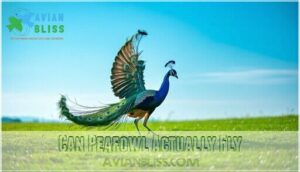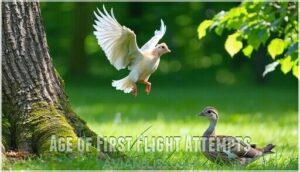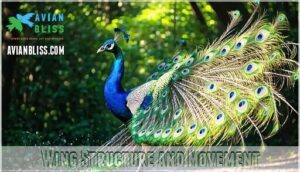This site is supported by our readers. We may earn a commission, at no cost to you, if you purchase through links.

These ornate birds manage short bursts of flight, reaching speeds around 10 mph and heights up to 30 feet. Think of them as the sprinters of the bird world – they’ll launch themselves into trees for roosting or escape predators, but don’t expect any cross-country journeys.
Their massive tail feathers create quite the aerodynamic challenge, like flying with a fancy banner trailing behind. Males especially look like they’re hauling around nature’s most elaborate luggage.
While their flight style resembles controlled falling more than graceful soaring, there’s fascinating science behind how they manage it.
Table Of Contents
- Key Takeaways
- Peafowl Flight Basics
- Can Peafowl Actually Fly
- Peafowl Flight Development
- Flight Patterns and Species
- Peafowl Flight Speed and Mechanics
- Factors Influencing Flight
- Male Vs Female Peafowl Flight
- Peafowl Flight in Captivity
- Why Peafowl Don’t Fly Frequently
- Frequently Asked Questions (FAQs)
- Conclusion
Key Takeaways
- You’ll find that peafowl can fly short distances of 100-150 meters at speeds around 10-12 mph, but they’re built for quick bursts rather than sustained flight due to their heavy bodies and ornate tail feathers that create significant drag.
- You can expect peafowl to use flight primarily for escaping predators and reaching roosting spots up to 8 feet high, since their wing structure works like helicopter rotors for explosive vertical takeoffs rather than long-distance travel.
- You’ll notice male peacocks have more difficulty flying than females because their elaborate tail feathers can weigh up to 60% of their body length, requiring much more energy for takeoff and limiting their aerial maneuverability.
- You should know that peafowl prefer staying grounded for energy conservation, spending only 2.6% of their time in flight while using their strong legs for daily activities like foraging and escaping danger through quick sprints.
Peafowl Flight Basics
You’ve probably watched peacocks strutting around with their impressive tail feathers and wondered if those heavy, ornate birds can actually get off the ground.
Peafowl can indeed fly, though they’re built more like short-distance sprinters than marathon fliers, reaching speeds of 10-12 mph and covering distances up to 150 meters when they need to escape danger or reach their nighttime roosts, which is a remarkable feat considering their physical attributes and the primary purpose of their impressive tail feathers.
General Flight Capabilities
Many peacocks surprise people with their flight characteristics, launching vertically up to 8 meters high.
You’ll see these magnificent birds demonstrate agile maneuvering as they twist through trees, avoiding obstacles with impressive precision.
Both males and females share similar abilities regarding peafowl flight. While peacock flying isn’t their preferred mode of transport, their peafowl abilities prove they’re far from flightless, showcasing remarkable flight capabilities when needed.
Flight Mechanics and Physical Constraints
Understanding peafowl flight mechanics reveals fascinating physical constraints that limit their aerial abilities.
These magnificent birds face unique challenges when taking to the skies.
Here’s how their body design affects flight performance:
- Tail Aerodynamics – Those stunning tail feathers create significant drag during flight
- Wing Loading – Heavy bodies strain relatively small wings beyond ideal ratios
- Energy Expenditure – Flight muscles work overtime, quickly exhausting their reserves
- Muscle Strength – Powerful but not built for sustained aerial performance
- Flight Speed – Mechanics limit them to brief 10-12 mph bursts
Factors Affecting Flight Ability
Several key factors determine your peafowl’s flight abilities.
Wing injuries can ground them permanently, while poor feather condition reduces lift capacity.
Muscle strength directly impacts peacock flight distance and takeoff power.
Environmental obstacles like dense vegetation limit flight paths, and genetic predisposition influences peafowl wingspan and natural flight adaptations.
These elements collectively shape each bird’s aerial capabilities and overall flight performance.
Birds must balance lift and thrust for effective flight.
Can Peafowl Actually Fly
You might be surprised to learn that peacocks can indeed fly, despite their reputation as ground-dwelling birds with elaborate tail feathers.
These magnificent birds achieve flight speeds of 10-12 mph and can reach heights up to 15 meters, though they typically limit their aerial activities to short bursts covering distances of 100-150 meters, showcasing their unique ability to fly.
Flight Distance and Height
Peafowl achieve impressive peacock flight distance reaching 90-150 meters in single bursts, with Maximum Distance rarely exceeding 500 feet.
Their flight altitude peaks at 25 meters, though most flights stay below 10 feet for Obstacle Clearance.
Flight Purpose centers on escaping predators and reaching roosting spots, utilizing techniques such as Gliding vs. Flapping for efficient movement.
They’re capable of bursts of speed, reaching approximately 10 miles per hour in the air.
Average Flight Speed
When you’re watching peafowl take flight, they’ll reach speeds of 10-12 miles per hour—about as fast as you’d jog leisurely.
This peacock flight speed remains consistent whether they’re escaping predators or reaching roosting spots.
Speed factors like body weight and wing structure limit their flying speed, but it’s perfectly adequate for their short-distance flight needs and survival requirements.
Peacocks typically fly to a height of around 8 feet, which is sufficient for reaching roosting spots.
Purpose of Peafowl Flight
While peafowl aren’t built for marathon flights, their flying abilities serve specific survival purposes.
You’ll observe these birds using flight primarily to escape predators when threatened, with their powerful wings launching them to safety.
Flight also helps with obstacle avoidance, reaching elevated roosting spots at night, and accessing food sources.
Territorial display behaviors occasionally involve short aerial demonstrations during mating season.
Peafowl Flight Development
You’ll discover that baby peafowl can actually fly within just three days of hatching, though they don’t attempt it right away to avoid injury.
These young birds spend their first few months learning proper flight techniques through practice and parental guidance, gradually building the strength and confidence needed for controlled aerial movements.
Age of First Flight Attempts
Within three days of hatching, peachicks develop flight feathers and can technically fly, though they avoid doing so for several weeks.
This early feather development serves as a survival mechanism against ground predators.
Flight training begins around three months with parental encouragement, helping young birds build strength and confidence while avoiding falls that could cause serious injury.
Learning Process and Milestones
Young peachicks don’t become ace pilots overnight.
Their flight development follows predictable age milestones, requiring dedicated flight practice and skill improvement. You’ll notice flight confidence building gradually through repeated flight training sessions.
Key learning milestones include:
- Week 1-2: Basic wing-flapping exercises and short hops
- Month 2-3: First sustained flights lasting several seconds
- Month 4-6: Coordinated takeoffs and controlled landings
- Month 6+: Flight mastery with obstacle navigation
Parental Guidance in Flight Training
Dedicated parents play vital roles in their peachicks’ flight development through encouragement methods and safety precautions.
You’ll observe adult peafowl demonstrating proper takeoff techniques while monitoring their young’s flight practice. This skill acquisition process involves gradual weaning flight attempts, where parents guide learning through flight demonstration.
Here’s how parental involvement shapes successful skill development:
| Training Stage | Parental Role | Peachick Response | Duration |
|---|---|---|---|
| Initial Attempts | Encouragement calls | Hesitant flapping | 1-2 weeks |
| Flight Practice | Safety monitoring | Short hops | 2-4 weeks |
| Skill Development | Demonstration flights | Improved coordination | 4-8 weeks |
| Weaning Flight | Reduced supervision | Independent flying | 8+ weeks |
The table outlines the progression of parental involvement in the development of their peachicks’ flying abilities, from initial attempts to independent flying.
Flight Patterns and Species
You’ll discover that different peafowl species show surprising variations in their flight abilities, with Green Peafowl outperforming their Indian cousins due to longer wings and lighter tails.
Understanding how each species’ unique body structure affects their aerial performance reveals why some peacocks struggle more than others when they take to the skies.
Differences in Flight Ability
Different peacock species showcase varying flight capabilities based on their unique characteristics.
You’ll notice these key distinctions when observing their flying abilities:
- Indian Peafowl demonstrate stronger short-distance flight skills despite heavy plumage
- Green Peafowl exhibit more limited flight potential due to increased body mass
- Congo Peafowl show better flight capabilities with lighter tail configurations
Genetic factors and environmental adaptation substantially influence each species’ wings and overall bird flight performance.
Impact of Tail Feathers on Flight
You might expect that magnificent tail to ground peafowl, but research reveals otherwise.
Those elaborate feathers don’t substantially hinder flight abilities or maneuverability.
The tail’s aerodynamics actually work well during flight, spreading wide like a fan.
While feather weight adds some burden, peafowl have adapted their flight mechanics to accommodate their stunning display plumage without major performance penalties, and their elaborate feathers don’t cause significant issues, allowing them to maintain their stunning display.
Weight and Aerodynamics
You’ll find that peacocks face serious aerodynamic challenges during flight.
Their ornate tail feathers create significant drag while adding substantial feather weight to their already hefty body mass of up to 13 pounds.
This creates high wing loading that reduces flight efficiency dramatically.
Their wings must work overtime to generate enough lift, explaining why their flight abilities remain limited to short bursts.
Birds also utilize wing adjustments for aerodynamics to optimize their flight.
Their physical attributes and behaviors, such as the use of wing adjustments, contribute to their unique flight patterns.
Peafowl Flight Speed and Mechanics
When you watch a peacock take flight, you’ll notice they launch almost straight up with powerful wing beats that sound like thunder, reaching speeds of 10-12 mph during their brief aerial journeys.
Their wing structure works like a helicopter’s rotors during takeoff, with strong chest muscles providing the force needed to lift their heavy bodies and ornate tail feathers off the ground, utilizing their powerful wing beats to achieve this feat with brief aerial journeys.
Takeoff and Landing Techniques
When you watch a peacock prepare for takeoff, you’ll notice their remarkable vertical launch technique.
These feathered rockets defy gravity with explosive power, launching straight up like nature’s own helicopters.
They crouch low, then explode upward with powerful leg muscles while rapidly beating their wings. This ground preparation allows them to clear obstacles up to 8 feet high.
Their flying capabilities rely on this initial burst rather than sustained flight. During controlled descent, peacocks spread their wings wide to reduce landing impact.
You’ll see them adjust their flight altitude based on terrain, demonstrating impressive flight patterns despite their size.
Here’s what makes peacock takeoffs truly spectacular:
- The explosive power – They launch like feathered rockets, defying their heavy appearance
- Split-second timing – Every muscle fires in perfect coordination for maximum lift
- Graceful landings – Despite their bulk, they touch down with surprising elegance
- Obstacle mastery – Trees, fences, and buildings become stepping stones in their aerial dance
- Natural confidence – Each flight shows centuries of evolutionary refinement in action
Wing Structure and Movement
When you examine a peacock’s wing morphology, you’ll discover fascinating skeletal adaptations that enable their unique flight style.
Their wings span 40-50 centimeters with rounded tips, designed for explosive takeoffs rather than sustained soaring.
Flight feathers create lift through specialized feather aerodynamics, while pectoral muscles generate the muscle power needed for wing beats averaging 10-15 per second.
| Wing Component | Measurement | Function | Limitation |
|---|---|---|---|
| Wing Length | 40-50 cm | Lift generation | Short for body size |
| Flight Feathers | 10-12 primary | Thrust production | Limited surface area |
| Wing Beat Rate | 10-15/second | Propulsion | High energy cost |
| Muscle Mass | 15-20% body weight | Power generation | Less than flying specialists |
Understanding these flight biomechanics and avian flight principles explains why peacocks can’t sustain long-distance bird flight mechanics like eagles or hawks.
Factors Influencing Flight
You’ll find that several key factors determine how well a peacock can fly, from their age and physical condition to the environment around them.
These variables work together to either enhance or limit their flight abilities, affecting everything from takeoff success to maximum flight distance.
Age and Development
Young peachicks develop flying ability within days of hatching, though they rarely attempt peachick flight immediately.
Their juvenile development includes essential flight training around 2-3 months when parents encourage practice.
As peafowl mature, their flying ability peaks during early adulthood, however, maturity impact shows decreased flight frequency with age.
Throughout their lifespan flight capabilities remain intact but become less utilized as birds grow heavier and more terrestrial.
Physical Condition and Injuries
Beyond developmental factors, your peafowl’s physical condition dramatically affects their flying capabilities.
Wing injuries and feather damage can ground these magnificent birds permanently, while muscle weakness reduces their already limited aerial abilities.
Common flight ailments include:
- Damaged primary flight feathers preventing efficient wing movement
- Wing trauma from accidents or fights with other birds
- Clipped wings in captivity restricting natural flight patterns
These physical limitations create significant health impact on their mobility and escape responses.
Addressing these issues may require specialized peafowl wing repair.
Environmental Factors
Dense jungle habitat provides natural camouflage, reducing your peafowl’s need for frequent flight.
Open terrain forces more aerial movement to escape predators, while food availability near ground level keeps them earthbound.
Climate effects like strong winds can ground even healthy birds.
Predator density directly impacts flying capabilities – areas with fewer ground threats mean less motivation to take wing despite environmental factors.
Male Vs Female Peafowl Flight
Peafowl flight varies substantially between males and females due to physical differences. Male peacocks carry ornate tails weighing up to 60% of their body length, creating substantial tail weight that impacts flight performance. Females fly more efficiently with lighter plumage impact and streamlined bodies.
Both sexes reach similar flight height of 8 feet, but speed differences emerge during takeoff. Males expend greater energetic costs lifting their decorative trains, while peahens achieve quicker acceleration.
These gender-based flight variations reflect evolutionary adaptations balancing display needs with aerial mobility requirements. Peahens, with their muted colors, use plumage for camouflage to protect themselves and their nests.
| Flight Aspect | Male Peacocks | Female Peahens |
|---|---|---|
| Tail Weight | Up to 60% body length | Short, practical feathers |
| Takeoff Speed | Slower due to plumage | Faster acceleration |
| Flight Duration | Brief bursts only | Slightly longer flights |
| Energy Required | High energetic costs | More efficient flight |
| Maximum Height | 8 feet average | 8 feet average |
Peafowl Flight in Captivity
You’ll find that captive peafowl face significant flight restrictions compared to their wild counterparts, primarily due to wing clipping and confined spaces.
Most zoos and farms limit their flight capabilities to prevent escapes, though these birds can still jump up to 8 feet high even with trimmed flight feathers.
Flight Behavior in Zoos and Farms
In zoos and farms, you’ll notice peafowl exhibit modified flight behavior due to captivity constraints.
Wing clipping commonly restricts their natural abilities, though they still attempt short flights within enclosures.
To address this, some owners explore peafowl flight control.
Their roosting habits remain intact as they seek elevated perches at dusk.
Human interaction influences their flight patterns, with some birds becoming less inclined to fly frequently around caretakers, which can be related to peafowl flight restriction.
Impact of Enclosure Size on Flight
Small enclosures severely limit peafowl flight capabilities, restricting natural movement patterns.
You’ll notice behavioral changes when peacocks can’t achieve their typical 100-meter flight distance. Cramped spaces force wing clipping practices, further reducing mobility.
Captive breeding programs require adequate space – at least 8-meter-high fencing allows vertical takeoffs. Consider peafowl enclosure products for appropriate housing.
Proper enclosure size maintains flight skills essential for peafowl wellbeing and natural behaviors, ensuring the birds can engage in their natural movement patterns.
Conservation Efforts and Flight Preservation
Several conservation programs focus on habitat preservation to maintain peafowl’s natural flight capabilities.
You’ll find anti-poaching efforts protecting genetic diversity while flight rehabilitation centers help injured birds recover their aerial abilities.
Sustainable ecotourism supports peafowl conservation by funding protected areas, and these initiatives guarantee flight adaptations aren’t lost, addressing flight limitations through thorough ecosystem management that preserves essential flight capabilities.
Why Peafowl Don’t Fly Frequently
You’ll notice peafowl spend most of their time walking because flight requires tremendous energy for their heavy, 13-pound bodies.
They’ve adapted to ground life where they can find food easily and use their strong legs to escape danger, making flight unnecessary except for reaching roosting spots or avoiding immediate threats.
Terrestrial Adaptation Advantages
You’ll find that peacocks have mastered life on the ground through millions of years of evolution.
Their terrestrial adaptations give them serious advantages over flying cousins.
Ground foraging lets them scratch up insects, seeds, and small animals that flying birds miss.
Their strong legs provide excellent predator avoidance through quick sprints and sudden direction changes, making flight unnecessary for survival.
Energy Conservation Strategies
You’ll notice peafowl are masters of energy conservation, using flight minimization to preserve precious calories.
Their metabolic rate stays lower when they stick to ground-based activities rather than energy-intensive aerial maneuvers.
Here’s how they maximize foraging efficiency:
- Thermal regulation through strategic roosting choices in shaded areas
- Ground-level foraging reduces energy expenditure compared to aerial hunting
- Selective flight only when absolutely necessary for survival
This smart approach balances their flight capabilities with practical energy management. This is because flight creates significant metabolic demands of flight.
Predator Evasion Techniques
When predators threaten, you’ll notice peafowl use sophisticated evasive maneuvers beyond simple flight.
These birds rely on sharp alarm calls to warn their flock, creating powerful group defense systems.
Their brilliant plumage actually provides camouflage use against color-blind predators.
Rather than wasting energy on constant flight, peafowl adaptations include strategic roosting safety in trees and quick escape bursts when danger strikes.
Frequently Asked Questions (FAQs)
Is peafowl a flightless bird?
No, you shouldn’t consider peafowl flightless birds.
They’re actually capable fliers, though they prefer staying grounded.
You’ll see them fly short distances to escape danger, reach roosting spots, or cross obstacles when necessary, which makes them quite capable.
What bird can’t fly?
Picture grounded giants shuffling across landscapes—you’ll encounter ostriches, emus, cassowaries, and kiwis as nature’s flightless wonders.
These birds traded soaring for speed, size, or stealth, proving that staying earthbound can be evolution’s brilliant strategy.
What is the difference between peafowl and peacock?
You’ll find that "peafowl" refers to the entire species, while "peacock" specifically means the male bird.
The females are called "peahens," and their babies are "peachicks."
It’s like saying "cattle" versus "bull", where peafowl is the broader term that encompasses all members of the species.
Which peacock has wings?
All peacocks have wings!
Both male peacocks and female peahens possess fully functional wings that enable short-distance flight.
You’ll see them use their wings to escape danger, reach roosting spots, and navigate obstacles in their environment, which is a fully functional aspect of their behavior, and they also use their wings for short-distance flight.
Can the peacock fly?
Like a magnificent phoenix that chooses when to rise, you’ll discover peacocks can indeed fly short distances—typically under 150 meters at speeds around 10 mph.
They prefer walking but take flight when escaping danger or reaching roosting spots.
How far can a peafowl fly?
You’ll typically see peafowl fly short distances of 100-150 meters, though they can push up to 1 mile when necessary.
They’re not marathon fliers—think quick hops rather than cross-country journeys through the sky.
Will peafowl fly away?
Only 6% of their time involves flight, yet peafowl might fly away if they’re not properly contained.
You’ll need eight-foot fences since they can leap that high.
Most domesticated birds stay close for food and roosting comfort.
How high can peacocks fly?
You’ll see these magnificent birds reach heights of about 8 feet when they jump and flap their wings together.
They can’t soar like eagles, but they’ll clear treetops to roost safely at night.
Do white peafowl fly differently?
White as clouds against blue sky, white peafowl don’t fly differently than their colorful cousins.
You’ll find they share identical flight capabilities, distances, and mechanics.
Their feather color doesn’t affect their short-burst flying abilities or roosting habits.
What are the biggest threats to flight?
Predators force you into risky flights, while wing injuries ground you completely.
Heavy ornate tails create drag, making escape harder.
Clipped wings from captivity eliminate your natural abilities entirely, leaving only dangerous jumps.
Conclusion
Like puzzle pieces finally clicking into place, peafowl flight capabilities make perfect sense when you understand their limitations.
Yes, can peafowl fly – but they’re designed for quick escapes and tree roosting rather than long-distance travel.
Their ornate plumage creates aerodynamic challenges that limit sustained flight.
You’ll find these birds prefer walking and running for daily activities, reserving their 10 mph flying skills for emergencies and reaching safe perches at dusk.
- https://indianbirds.in/pdfs/IB7.5_Rajeshkumar_Balasubramanian_IndianPeafowl.pdf
- https://assortedregards.com/2021/07/15/peafowl-in-history-culture/
- https://birdwatchingtoday.com/can-peacocks-fly/
- http://www.leeds.ac.uk/news/article/3585/peacocks_train_is_not_such_a_drag
- https://www.sciencedaily.com/releases/2014/09/140917173237.htm














